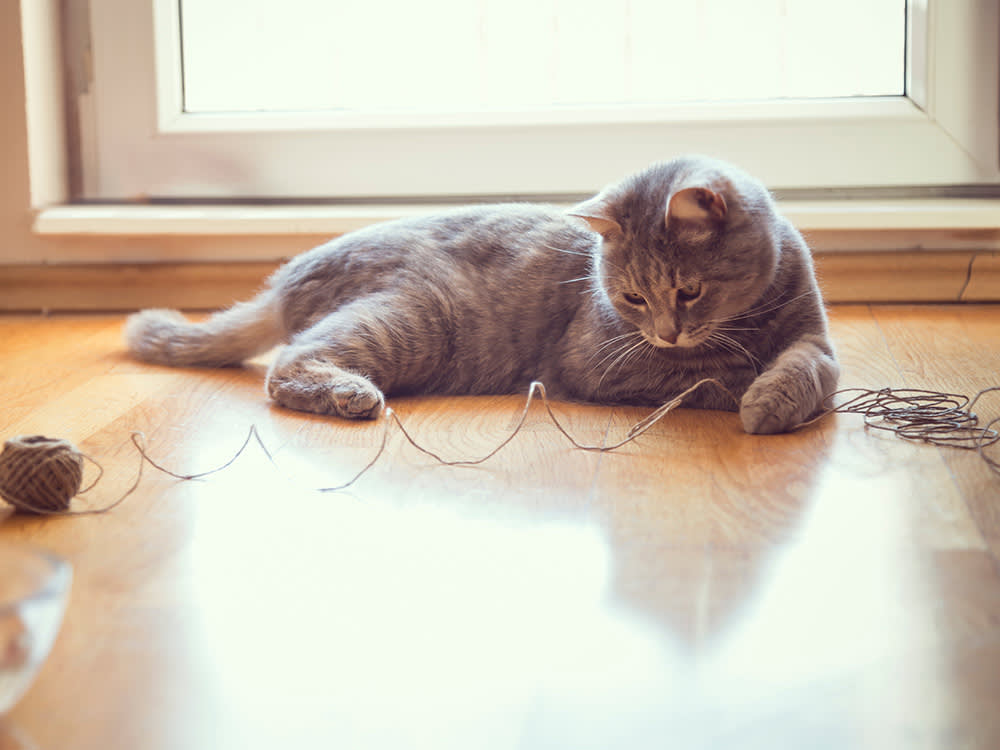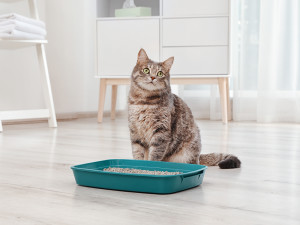How to Treat Intestinal Blockages in Cats
If you see a string sticking out from, uh, behind, never, ever, ever pull on it

Share Article
You buy your cat a bed and watch them sleep in a cardboard box. You give your cat a scratching post only for them to drag their claws through your furniture. You provide safe toys for entertainment, and then your cat plays with things they shouldn’t like pencil erasers, scrunchies and that crochet project you abandoned months ago. Now, your cat is vomiting, and you can’t find the thing they were playing with. Oh, crap. Let’s talk about cats with foreign bodies.
What is a gastrointestinal obstruction?
A gastrointestinal (GI) obstruction most commonly occurs when a cat eats a non-food item that is unable to pass through the GI tract. Objects can get trapped in the stomach and/or small intestines and cause nausea, vomiting and abdominal pain. Cats get themselves into trouble by eating toys, hair ties and pieces of plastic or metal. And they are notorious for being fascinated by and accidentally swallowing stringy things like wool, thread, ribbon and shoe strings. Pro tip: don’t let your cat play with wool, no matter how cute they are batting it around.
Gastrointestinal obstructions can generally be placed into three categories: partial, complete and linear. Partial obstructions occur when foreign material in the GI tract still allows some food and liquid to pass through. In complete obstructions, the GI tract is totally blocked and no food or water can pass. Symptoms seen with partial obstructions may be less severe or slower to develop than those seen with complete obstructions.
When a cat swallows string, one end of the string can get anchored early in the digestive tract, usually under the tongue. The free end of the string continues to try to move through the intestines. Because the string is anchored, the normal movement of the GI tract will cause the intestines to bunch up around the string instead of pushing it through. This bunching is called plication and is one of the hallmarks of a linear obstruction.
Despite this bunching, the intestines will continue to try to push the string through, causing a lot of friction against the intestinal wall. This can eventually lead to a tear. A hole in the intestines is bad news – all of the bacteria-riddled goo that is usually held in the intestines leaks into the abdominal cavity. This causes a serious infection that will make a cat very sick, very quickly.
Symptoms of gastrointestinal obstructions in cats
The most common symptoms in cats with GI obstruction are vomiting, loss of appetite, and lethargy. These symptoms can be seen with both major and minor problems, so any vomiting or appetite change warrants a visit to your veterinarian. Symptoms typically seen with gastrointestinal obstructions include:
vomiting
anorexia
lethargy
abdominal pain
diarrhoea
Diagnosing gastrointestinal obstruction in cats
Your veterinarian will start with a physical exam. This includes checking for string under the tongue and palpating the abdomen to determine if your cat has abdominal pain or palpable foreign material or plication. Most GI obstructions in cats are diagnosed with abdominal radiographs.
If a GI obstruction is suspected but is not obvious on abdominal radiographs, an abdominal ultrasound may be recommended. Abdominal ultrasound is often more sensitive than radiographs for seeing foreign material, plication and evidence of intestinal leakage. Ultrasound can also identify physical abnormalities like tumours that can cause obstruction.
Blood work is often performed to determine the severity of dehydration and look for evidence of infection or intestinal leakage. It can also be useful in ruling out other causes of vomiting.
Treatment for gastrointestinal obstructions in cats
Most cats with a GI obstruction require surgical intervention. Surgery is performed under general anaesthesia and is accompanied with supportive care like fluid therapy, pain control and anti-nausea medication. During surgery, the veterinarian will remove foreign material and evaluate the health of the intestinal tract.
Obstructed guts tend to be inflamed, and if they’ve been bunched up or blocked off for too long they get weak and tear. Leaky guts are useless guts that need to be removed. This procedure is called a resection and anastomosis. Basically, the crappy portion of the intestine is removed and the unaffected parts are connected to create a happier, healthier tube. Resection and anastomosis is more commonly needed with linear obstructions or complete obstructions that went too long without treatment. This is why prompt treatment is best if an intestinal obstruction is suspected.
A less invasive option is endoscopy, in which a camera is passed down the oesophagus into the stomach and a retrieval instrument is used to remove the foreign body. Endoscopy is considered an option only if the foreign body is isolated to the stomach and easily grabbable with small instruments. General anaesthesia is still required.
Your cat probably needs help
If a cat ingested foreign material and is having symptoms, such as vomiting and anorexia, treatment is required. In cases of partial intestinal obstruction, some cats respond to fluid therapy and close monitoring. The goal is to achieve adequate hydration in hopes that it will help the intestines move things along. This is not always successful and surgery is considered the next step in treatment. Waiting for your cat to pass an object increases the risk of a tear in the intestines if it doesn’t want to move on.
Never pull a string from your cat’s bum
Do not. Under any circumstances. Pull a string from your cat’s bum. Ever. If you’re seeing one end of a string, that means the other end could be anchored somewhere else in your cat’s GI tract (maybe as far up as the tongue). Pulling the string can put tension and friction on the intestines, possibly worsening plication and cutting a hole into the intestinal wall. As tempting as it can seem, don’t do it. Just get your cat to the vet.
If you have any concern that your cat has an intestinal foreign body, the best course of action is to seek veterinary care. Diagnostics can determine if your cat can be treated with medications and monitoring, or if prompt surgery is recommended.

Dr. Alycia Washington, DVM, MS
Alycia Washington, DVM, is a small animal emergency veterinarian based in North Carolina. She works as a relief veterinarianopens in new tab and provides services to numerous emergency and specialty hospitals. She also works as a veterinary writer with a focus on educating pet owners.
Related articles
![Cat sitting by its litter box]()
Is Your Cat Full of Sh*t?
Seriously, though – here’s how to deal with cat constipation
![cat sitting in a litter box]()
How to Deal with Cat Diarrhoea
Dr Audrey K Cook’s tips to getting to the bottom of a sh*tty situation
![Mom cat and her kittens.]()
How to Tell if a Cat is Pregnant
Are kittens on the way? Here’s how to find out
![A grey cat walking away with its tail pointing upwards.]()
Do Cats Fart?
Causes and remedies for cat flatulence
![Siberian cat licking her paw outdoors.]()
What to Know About Tapeworms in Cats
What to look for and how to treat it (to be able to eat rice again)
![Tabby cat leaning into a porcelain sink, tail curled in the air, as it sticks its tongue out to drink water from the faucet.]()
Why Is My Cat So Damn Thirsty?
No, not like that. They’re literally drinking a lot of water. Here’s when you should be worried








